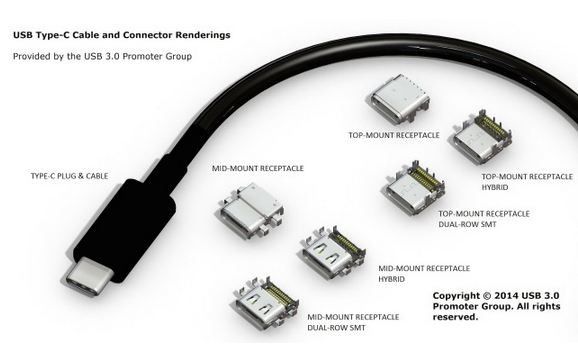New USB Type-C Connector Finalized
| Marc Maligalig | | Aug 13, 2014 05:10 AM EDT |
(Photo : USB 3.0 Promoters Group) USB Type-C cable and connectors
The USB 3.0 Promoter Group has just announced the new reversible USB Type-C connector is ready for mass production. The new connector will address problems previously met by USB connections.
The USB Type-C specification establishes a new cable and connector scheme tailored to fit mobile device product designs, yet is robust enough for laptops and tablets.
Like Us on Facebook
The new USB Type-C sports a completely new design and is backwards compatible with other USB ports. The USB Type-C plug is a new type of USB plug designed to replace every size of all current USB connectors.
The new connector is reversible so it can be used in any orientation. Its size is similar to the dimensions of the USB 2.0 Micro-B, which is the standard smartphone USB connector and charging cable.
It's thin enough to fit in the ports of mobile phones and but strong enough for tablets and laptops. The new design has a reversible plug orientation to ease the insertion.
The new USB connector can provide up to five amperes of power while its cables are able to support three amps for a maximum of 100 watts of power.
It has a transfer rate of the USB 3.1 data cables, which amounts to 10 gigabytes per second. It's durable enough to endure 10,000 connect-disconnect cycles.
The release of the USB Type-C specification is the final piece in developing a single-cable solution.
The combination of SuperSpeed USB 10 Gbps and USB Power Delivery up to 100W with the slim, user-friendly USB Type-C connector provides endless possibilities, said the USB 3.0 Promoters Group.
Since its adoption in 1996, the Universal Serial Bus, or USB, has been a standard on computers. During its debut, it was relatively fast, with transfer speeds reaching 12 megabytes per second.
The connector's form factor wasn't a problem on the big desktop computers of the period. As the years passed, however, the connectors were changed to fit the new USB ports as specifications for the USB were updated numerous times.
The USB-A and USB-B developed in the early 1990s sported a big connector and could only provide 100 milliamps of power to plugged-in devices. The limitations of the first USBs were taken care of as the USB evolved over the years.
©2015 Chinatopix All rights reserved. Do not reproduce without permission
EDITOR'S PICKS
-

Did the Trump administration just announce plans for a trade war with ‘hostile’ China and Russia?
-

US Senate passes Taiwan travel bill slammed by China
-

As Yan Sihong’s family grieves, here are other Chinese students who went missing abroad. Some have never been found
-

Beijing blasts Western critics who ‘smear China’ with the term sharp power
-

China Envoy Seeks to Defuse Tensions With U.S. as a Trade War Brews
-

Singapore's Deputy PM Provides Bitcoin Vote of Confidence Amid China's Blanket Bans
-

China warns investors over risks in overseas virtual currency trading
-

Chinese government most trustworthy: survey
-

Kashima Antlers On Course For Back-To-Back Titles
MOST POPULAR
LATEST NEWS
Zhou Yongkang: China's Former Security Chief Sentenced to Life in Prison

China's former Chief of the Ministry of Public Security, Zhou Yongkang, has been given a life sentence after he was found guilty of abusing his office, bribery and deliberately ... Full Article
TRENDING STORY

China Pork Prices Expected to Stabilize As The Supplies Recover

Elephone P9000 Smartphone is now on Sale on Amazon India

There's a Big Chance Cliffhangers Won't Still Be Resolved When Grey's Anatomy Season 13 Returns

Supreme Court Ruled on Samsung vs Apple Dispute for Patent Infringement

Microsoft Surface Pro 5 Rumors and Release Date: What is the Latest?










